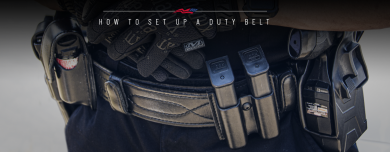
Most police agencies use hip holsters instead of thigh holsters for their officers, but are they the better option?
Hip holsters have maintained popularity with law enforcement agencies. Many agencies require officers to use only hip holsters and forbid any other type of holster, such as thigh holsters, except for special operations units. Would a thigh holster be a better option for patrol officers as well? Here are some pros and cons to consider.
Pros of thigh holsters
There are some good things to be said for thigh holsters.
Positioning
The single biggest pro for a thigh holster is that, when worn correctly, a thigh holster places a sidearm at nearly the exact spot the hand naturally falls to the side of the body. Hip holsters require the officer to reach high up to retrieve the weapon and bring the arm up even higher to remove the weapon from the holster. This type of action is not only slower, but may also be difficult, or impossible, in an active fight or in very close quarters. It may also be far more difficult, or impossible, if the officer’s arm becomes injured for any reason.
Easier Access With Non-Dominant Hand
While we’re on the subject of injured arms, an important pro to the thigh holster is that it can be accessed with the non-dominant hand. If an officer’s gun hand or arm becomes immobilized, they may not be able to access their firearm, especially larger officers who simply cannot reach around their torso with their non-dominant arm to retrieve their weapon.
Less Weight Around the Waist
Officers are expected to carry an incredible amount of weight on their duty belt. Over time, this weight can cause pain or injury to the officer’s back and/or hips. Shifting the weight distribution to a leg will reduce the total weight around the waist.
Frees Up Room for More Equipment
Okay, I know I am undoing the previous pro by adding this, but, for those who aren’t concerned about the weight of their duty belt, having a thigh holster will free up some room for other equipment, such as more ammo. Additionally, for officers with a smaller waist, this may be the only way he or she can carry all of their necessary equipment.
Cons of thigh holsters
Possible Retention Issues
Hip holsters are closer to the torso, making it easier to retain immediately after removal from the holster. Thigh holsters, on the other hand, place your weapon further from the torso and in an easier position for the bad-guy to grab the weapon away from you.
Thigh holsters are too Tactical in Appearance
Yes, this matters. Police are being scrutinized for becoming too militarized. Thigh holsters add a combat-ish look to the uniform that hip holsters do not bring, comparatively speaking.
Gets in the Way
Thigh holsters are more cumbersome in many circumstances. They can be highly uncomfortable while driving around in the patrol unit, can get hung on fences while chasing the bad guy, they may interfere with running, and can interfere when ground fighting.
Thigh holsters have some excellent pros that may lure you into wanting one, only to find that the cons make them not ideal, at least not for regular patrol activities. Your best bet is to test drive a thigh holster before deciding which one works best for you or your department.
Disclaimer: The content in this article is the opinion of the writer and does not necessarily reflect the policies or opinions of US Patriot Tactical.






